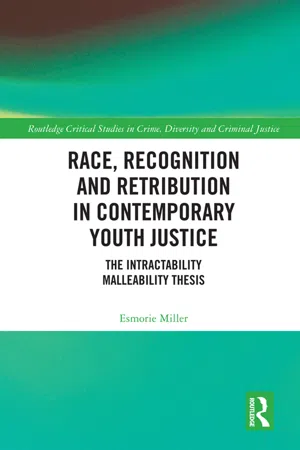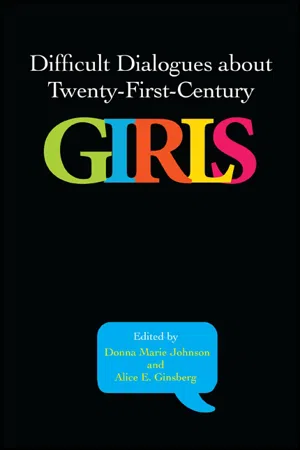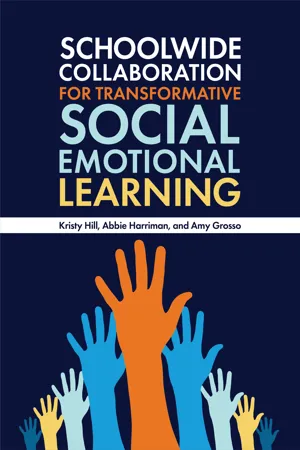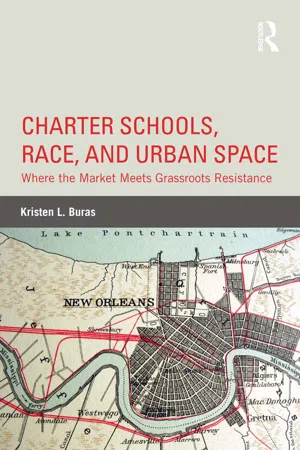History
Ruby Bridges
Ruby Bridges was the first African American child to attend an all-white elementary school in the American South. In 1960, at the age of six, she was escorted to school by federal marshals due to violent protests from white parents. Her bravery and perseverance helped pave the way for desegregation in schools.
Written by Perlego with AI-assistance
Related key terms
4 Key excerpts on "Ruby Bridges"
- eBook - ePub
Race, Recognition and Retribution in Contemporary Youth Justice
The Intractability Malleability Thesis
- Esmorie Miller(Author)
- 2021(Publication Date)
- Routledge(Publisher)
et al., 1994).Ruby Bridges, education segregation and the wider global context of racial exclusion
When Ruby Bridges was six years old US Federal Marshalls escorted her to school. This was the first time in her nascent student career that she received official protection. Ruby’s escort remained with her throughout that school year. The year was 1960 and Ruby had transferred to William Frantz Elementary School, New Orleans, Louisiana. It was the first time a Black student was permitted to attend the formerly all-White institution. The Marshalls escorted Ruby for her protection from all-White adult crowds, unrestrained in their outrage for what she represented. Ruby was the very possibility for the inclusion of racialized peoples as recipients of modernity’s promise of universal equality. Segregation, meanwhile, represented an antithesis. If you close your eyes you can conjure up an image of the scene: a small school child, sandwiched between her protection detail, making her way down the flight of stairs leading from her school building. She was surrounded by hostility; but in her small stature was a representation of her malleability, signifying much more than her discrete development as a person; she also embodied, in her malleability, the possibilities for a societal transformation away from that hostility, which had been gifted to people like her, by history. Finally, corresponding with a primary aim of the book, to expand narratives about Black youth away from the customary crime and punishment understanding with which they have been bound up, Ruby’s exclusion from education serves as an exemplar that experiences in one institution (whether YJ or education) indicate a more interdependent set of experiences of exclusion. Understood this way, exclusion can more appropriately be explained as a more widespread prohibition from rights and privileges, in general - Donna Marie Johnson, Alice E. Ginsberg, Donna Marie Johnson, Alice E. Ginsberg(Authors)
- 2015(Publication Date)
- SUNY Press(Publisher)
PART INew Ways of Knowing About Girls
Passage contains an image Chapter 1 Disrupting Invisibility Education Scholarship Meeting the Needs of African American Elementary and Secondary School Girls Donna Marie Johnson
And so, lifting as we climb, onward and upward we go, struggling and striving, and hoping that the buds and blossoms of our desires will burst into glorious fruition ere long. With courage, born of success achieved in the past, with a keen sense of the responsibility which we shall continue to assume, we look forward to a future large with promise and hope. Seeking no favors because of our color, nor patronage because of our needs, we knock at the bar of justice, asking an equal chance. (Terrell, 1898, p. 15)Linda Brown and Ruby Bridges are perhaps the two most enduring symbols of the struggle for school desegregation and educational equity in the United States. Both were African American school-aged girls at the early stages of their education. Linda’s father, Oliver, was the lead plaintiff in the 1954 Brown v. Board of Education case, which reversed the legality of “separate but equal schools” and triggered rising expectations and aspirations for equal opportunity and social justice, especially in the realm of education (Bennett, 2001). Linda, a third-grader in Topeka, Kansas, at the time, was denied access to an all-White school in her community based on her race; Oliver took action to ensure educational equity for his daughter. Ruby Bridges’ courageous and lonely walk to and from school each day, accompanied by federal guards and angry White protesters, was immortalized in a famous 1964 painting created by renowned American artist Norman Rockwell. Ruby and three other six-year-old African American girls who attended a nearby school endured racial taunts and violent threats from angry White mobs on a daily basis to gain equal access to education in the New Orleans public school system. Ruby received instruction in an empty classroom for a year, studying alone with her White female teacher, restricted from all other parts of the school and from other children. One day while walking to school, an angry White protester shoved a casket with a black baby doll inside, into Ruby’s face. She did not respond with fear like most six-year-olds would have, but instead looked straight ahead toward her and the nation’s improved future.- Kristy Hill, Abbie Harriman, Amy Grosso(Authors)
- 2021(Publication Date)
- Libraries Unlimited(Publisher)
Brown v. The Board of Education of Topeka, Kansas, ended segregation in public schools, the South continued to be segregated and Ruby went to kindergarten at an all-African American school. Before Ruby was to start first grade, the schools in Louisiana were ordered to desegregate. Before any African Americans were allowed to enter the traditionally all-white schools, they had to take a test. Ruby was one of five who passed the test. It was difficult for the family to decide if she should go to the all-white school only a few blocks away or the African American school. She ended up going to the white school and was the only Black student to attend that school. While her parents knew it was going to be difficult for her, they wanted her to have the best education (Michals 2015).On her first day of school, her mother walked with her, and they were met by numerous protesters who did not agree to schools being integrated. They were escorted by four federal marshals. Even though the school was integrated, she was taught by one teacher and was not allowed outside her one classroom. The school was integrated, but she was segregated within the school. She did not even see any other students during the day until the second part of the year. Her teacher would bring other students, all white, to the class where Ruby was (Carroll 2020).Ruby Bridges established The Ruby Bridges Foundation in 1999 to continue her work as an activist (Michals 2015). In an interview with USA Today in 2020, Ruby reflected on what she learned from such an enormous experience as a child, “I think the lesson that I learned is that you can’t look at a person and judge them. That you have to allow yourself an opportunity to really get to know them, no matter what they look like” (Carroll 2020).Ruby exhibited self-confidence not only in going to school that first day but also in continuing to go to school every day in spite of being the only Black student. In the face of protestors and those opposing the integration of schools, she continued to move forward. Because of this critical experience, Ruby has continued to espouse self-confidence as she continues to be an activist for civil rights.- eBook - ePub
Charter Schools, Race, and Urban Space
Where the Market Meets Grassroots Resistance
- Kristen L. Buras(Author)
- 2014(Publication Date)
- Routledge(Publisher)
1 Ms. Perks pondered, “I was reading [this] book yesterday and I said, ‘That school, it’s historical. What Ruby Bridges went through, it’s unreal.’ And things really haven’t changed that much. The school is closed” (Interview, 2008). Unfortunately, the racially motivated closing of schools in New Orleans is not a thing of the past. It is a thing of the present as well. A case in point is King Elementary.The destruction of the Lower 9th Ward provided education entrepreneurs and their state allies with an “unprecedented opportunity” to rewrite the geography of New Orleans along more exclusionary lines. But there was one problem: a long history of black activism in the Lower 9th Ward as well as veteran teachers and a principal at King Elementary with no intention of allowing such dispossession to occur. King’s principal, Ms. Gaines, explains, “We’re not strangers to struggle” (Interview, 2008). With most of the city’s public schools rapidly swept into a staterun Recovery School District (RSD) intent on creating the nation’s first charter school system, the Lower 9th Ward community had little “choice” after 2005. They could attempt to reopen by chartering the school or cease to exist.Based on oral history interviews with veteran teachers, administrators, and community members affiliated with King Elementary as well as school and community observations, this case study traverses time and space, documenting the community’s history of racial resistance and recent struggles for educational equity, including the fight to keep King Elementary on the map. These struggles are examined in the context of attempts to undermine the reconstruction of black neighborhoods and create a space for entrepreneurial control of public education through charter school reform and alternative teacher recruitment. As I will show, efforts to rebuild King Elementary in this newly reformed landscape reveal a distinct commitment to equity, culture, and a shared sense of place—the antithesis of the vacuous market-based policies that have guided New Orleans school reform. I argue that such commitments have enabled and energized grassroots educational resistance despite well-financed entrepreneurial efforts.
Index pages curate the most relevant extracts from our library of academic textbooks. They’ve been created using an in-house natural language model (NLM), each adding context and meaning to key research topics.



